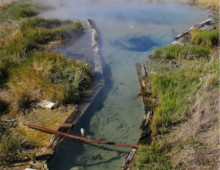“We used to think there were just plants and animals,” said Edward Rubin, director of the U.S. Department of Energy’s Joint Genome Institute. “Then we got microscopes, and got microbes. Then we got small levels of DNA sequencing.” Quanta magazine focused on a recent project led by Jill Banfield in Colorado, one that significantly increased the known…
Cleaning Up Bunker Oil with White Rot Fungi
Researchers evaluate how fungi better known for breaking down plant biomass do in a bioremediation application. The Science: Researchers evaluated the potential capabilities of six white rot fungi to break down oil in contaminated canal waters. The Impact: Though white rot fungi are known for their capabilities in breaking down components of plant cell walls,…
Unearthing Cornerstones in Root Microbiomes
Defining core members of a microbial community for normal plant growth Like the tip of an iceberg, a plant sprouting from the soil barely hints at what lies beneath. At the nexus where roots and soil intersect are thriving microbial communities that play important roles in plant health and growth. Understanding how plant yields can…
Matthew Sullivan, The Ohio State University
Departments of Microbiology, and Civil, Environmental and Geodetic Engineering, The Ohio State University, Columbus, OH Collaborated with JGI since 2001 How long have you collaborated with the JGI and on which projects? Since 2009 as head of my own lab, and since 2001 as a PhD student (with Penny Chisholm at MIT) working on the initial marine Prochlorococcus and…
The MiSIng Piece Revealed: Classifying microbial species in the genomics era
The rapid explosion in the throughput of DNA sequencing due to new technology platforms is fueling an increase in the number of sequenced microbial genomes and driving much greater availability of these data to the research community. Traditionally, identifying the microorganisms selected for sequencing is often decided on the basis of a single universal marker…
Celebrating the Eucalyptus Reference Genome
New Phytologist dedicates an entire issue to various research directions based on the tree genome. The Science: Building off the Eucalyptus grandis tree genome that researchers at the DOE Joint Genome Institute helped sequence and analyze, several researchers demonstrate the utility of the reference genome in the June 2015 special issue of New Phytologist. The…
Confirming Microbial Lineages Through Cultivation-Independent Means
Collaborative work culminates in evidence of a single candidate bacterial phylum. The number of microbes found on Earth has been compared to the number of stars in the Milky Way. Yet the proportion of those microbes that can actually be grown under laboratory conditions is so small it would be akin to those stars that…
Collaborator Janet Jansson in Quanta magazine
“[S]oon after the turn of the century, new high-octane DNA sequencing methods made it possible to sequence thousands or even millions of genes almost instantly. These new, speedier methods meant researchers could easily sequence the collective genomes of the sample, known as a metagenome, for the first time. Suddenly, it was possible to scan the…
Automating Microbial Genome Sequence Decontamination
Single cell genomics and metagenomics are pioneering techniques that have helped researchers assess environmental microbial community structure and function. As projects applying these techniques scale up, however, researchers are hindered by the lack of a high-throughput process to review assembled genome sequences. Currently, sequence decontamination of the microbial genomes being uploaded to public databases is…
Data Quality, Data Sets and New Directions: Plotting IMG’s Next 10 Years
Nikos Kyrpides received the Van Niel International Prize in Bacterial Systematics for the triennium 2012-2014. His efforts to systematically describe and classify microbes in action can be seen in the Integrated Microbial Genomes (IMG) data management system.







